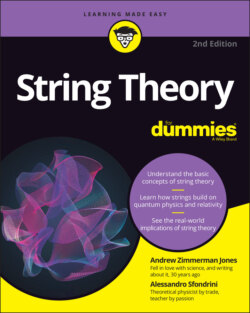Читать книгу String Theory For Dummies - Andrew Zimmerman Jones - Страница 95
Catching the wave
ОглавлениеWaves (as we usually think of them) move through some sort of medium. Like in the examples we discussed when talking about kinetic energy, tidal waves can move through the water, and sound waves through the air, with those materials acting as the medium for the motion. Similarly, if you flick the end of a jump rope or string, a wave moves along the rope or string. In classical physics, waves transport energy, but not matter, from one region to another. One set of water molecules transfers its energy to the nearby water molecules, which means that the wave moves through the water, even though the actual water molecules don’t really travel all the way from the start of the wave to the end of the wave.
This is even more obvious if we take the end of a jump rope and shake it, causing a wave to travel along its length. Clearly, the molecules at our end of the jump rope aren’t traveling along it. Each group of jump-rope molecules is nudging the next group of jump-rope molecules, and the end result is the wave motion along its length.
There are two types of mechanical waves, as shown in Figure 5-1:
Transverse wave: A wave in which the displacement of the medium is perpendicular to the direction of travel of the wave along the medium, like the flicking of a jump rope
Longitudinal wave: A wave that moves in the same direction in which the wave travels, like a piston pushing on a cylinder of water
FIGURE 5-1: Waves come in two types: transverse, shown on top, and longitudinal, shown on the bottom.
The highest point on a transverse wave (or the densest point in a longitudinal wave) is called a crest. The lowest point on a transverse wave (or the least dense point in a longitudinal wave) is called a trough.
The displacement from the resting point to the crest — in other words, how high the wave gets — is called the amplitude. The distance from one crest to another (or one trough to another) is called the wavelength. These values are shown on the transverse wave in Figure 5-1. The wavelength is shown on the longitudinal wave as well, although the amplitude is hard to show on that type of wave, so it isn’t included.
Another useful thing to consider is the velocity (speed and direction) of the wave. This can be determined by its wavelength and frequency, which is a measure of how many times the wave passes a given point per second. If you know the frequency and the wavelength, you can calculate the velocity. This, in turn, allows you to calculate the energy contained within the wave.
Another trait of many waves is the principle of superposition, which states that when two waves overlap, the total displacement is the sum of the individual displacements, as shown in Figure 5-2. This property is also referred to as wave interference.
FIGURE 5-2: When two waves overlap, the total displacement is the sum of the two individual displacements.
Consider waves when two ships cross each other’s path. The waves made by the ships cause the water to become choppier, and as the waves add height to each other, they cause massive swells.
Similarly, sometimes waves can cancel each other out. If the crest of wave 1 overlaps with the trough of wave 2, they cancel each other out at that point. This sort of interference plays a key role in one of the quantum physics problems we discuss in Chapter 7 — the double slit experiment.
